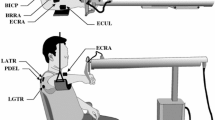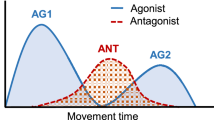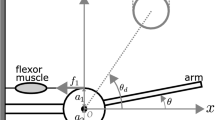Abstract
Through an experimental study of the stability properties of the human neuromuscular system while it performs simple point-to-point arm movements, this paper evaluates the concepts of equilibrium and virtual trajectories as a means of executing movement of the arm. Human subjects grasped the instrumented handle of a two-link robot manipulandum and performed specified point-to-point planar arm trajectories. Computer-controlled brakes were used to subtly change the movements by constraining the trajectory along an arc of radius equal to the length of one link of the manipulandum. Target points were arranged to lie along the arc so that the subject could complete the movement even when constrained. Three situations were tested: (1) unconstrained throughout the movement, (2) constrained through the entire movement, and (3) initially constrained and then released during movement. Experimental results showed that the constraint evoked significant forces strongly oriented so as to restore the hand to the unconstrained hand path. In addition, when released from the constraint, these forces caused a strong tendency to return the hand to the unconstrained path before the end of the movement was reached. Such strong positional stability properties of the arm reinforce the notion that a moving attractor point dominates the dynamics of the arm during movement. Additionally, bounds on the shape of the virtual trajectory were found which indicate that the equilibrium point remains close to the actual movement produced. These results, showing that a controlled equilibrium point may be used for planning and coordinating multijoint movements, are consistent with an equilibrium point hypothesis.
Similar content being viewed by others
References
Asatryan DG, Feldman AG (1965) Functional tuning of nervous system with control of movement or maintenance of a steady posture. I. Mechanographic analysis of the work of the joint on execution of a postural task. Biophysics 10:925–934
Bennett DJ, Hollerbach JM, Xu Y, Hunter IW (1992) Time-varying stiffness of the human elbow joint during cyclic voluntary movement. Exp Brain Res 88:433–442
Colgate JE, Hogan N (1988) Robust control of dynamically interacting systems. Int J Control 48:65–88
Dohrmann CR, Busby HR, Trujillo DM (1988) Smoothing noisy data using dynamic programming generalized cross-validation. J Biomech Eng 110:37–41
Flash T (1987) The control of hand equilibrium trajectories in multijoint arm movements. Biol Cybern 57:257–274
Gomi H, Koike Y, Kawato M (1992) Human hand stiffness during discrete point-to-point multijoint movement. International Conference of the IEEE Engineering in Medicine and Biology Society
Hogan N (1985) The mechanics of mult-joint posture and movement control. Biol Cybern 52:315–331
Jeannerod M (1991) The interaction of visual and proprioceptive cues in controlling reaching movements. In: Humphreys DR. Freund HJ (eds) Motor control: concepts and issues. Wiley, New York, pp 277–291
Kawato M, Katayama M, Gomi H, Koike Y (1992) Coordinated arm movements: virtual trajectory control hypothesis and learning inverse models. Proc Int Symp Inf Sci, July 15, 1992, Iizuka Kyusyuu, Japan
Lackner J, DiZio P (1992) Rapid adaptation of arm movement endpoint and trajectory to Coriolis force perturbations. Soc Neurosci Abstr 18(I):517
Lacquaniti F, Carrozzo M, Borghese NA (1993) Time-varying mechanical behavior of multijointed arm in man. J Neurophysiol 69:1443–1464
Latash ML (1993) Virtual trajectories and joint stiffness reconstructed with smooth perturbation technique under different instructions. Abstracts, 14th Congress of International Society of Biomechanics, July, part I, pp 758–759
Mansfield JM (1992) Functional assessment of amputee performance. PhD Thesis, Department of Mechanical Engineering, MIT
Morasso P (1981) Spatial control of arm movements. Exp Brain Res 42:223–227
Murphy MC (1990) Geometry and the kinematics of the normal human knee. PhD Thesis, Department of Mechanical Engineering, MIT
Mussa-Ivaldi FA, Hogan N, Bizzi E (1985) Neural, mechanical, and geometric factors subserving arm posture. J Neurosci 5:2732–2743
Shadmehr R, Mussa-Ivaldi FA, Bizzi E (1993) Postural force fields of the human arm and their role in generating multijoint movements. J Neurosci 13:45–62
Smith AM, Humphrey DR (1991) What do studies of specific motor acts such as reaching and grasping tell us about the general principles of goal-directed motor behavior? In: Humphreys DR, Freund HJ (eds) Motor control: concepts and issues. Wiley, New York, pp 357–381
Van Ingen Schenau GJ, Beek PJ, Bootsma RJ (1992) Is position information alone sufficient for the control of external forces? Behav Brain Sci 15:804–805
Whitney D (1977) Force feedback control of manipulator fine motions. J Dyn Syst Meas Control 99:91–97
Won J (1995) Modeling human performance of intermittent contact tasks. 6th IFAC Symposium on Analysis, Design, and Evaluation of Man-Machine Systems, June, pp 669–674
Author information
Authors and Affiliations
Rights and permissions
About this article
Cite this article
Won, J., Hogan, N. Stability properties of human reaching movements. Exp Brain Res 107, 125–136 (1995). https://doi.org/10.1007/BF00228024
Received:
Accepted:
Issue Date:
DOI: https://doi.org/10.1007/BF00228024




